Pioneer GM-D505 Handleiding
Bekijk gratis de handleiding van Pioneer GM-D505 (6 pagina’s), behorend tot de categorie Receiver. Deze gids werd als nuttig beoordeeld door 72 mensen en kreeg gemiddeld 4.3 sterren uit 36.5 reviews. Heb je een vraag over Pioneer GM-D505 of wil je andere gebruikers van dit product iets vragen? Stel een vraag
Pagina 1/6

Setting the Unit
Gain Control and Bass Level
Control
Adjusting the gain controls A and B and
the bass level control (CH SUB) will
help match the output of the car stereo
to the Pioneer amplifier. Normally, set
these controls to the “NORMAL
(NORM.)” position. If the output is low,
even when the volume of the car stereo
is turned up, turn these controls clock-
wise. If there is distortion when the vol-
ume of the car stereo is turned up, turn
these controls counter-clockwise.
• If you only use one input plug, set the gain
controls for speaker outputs A and B to the
same position.
• When using with an RCA equipped car
stereo (standard output of 500 mV), set to
the NORMAL position. When using with
an RCA equipped Pioneer car stereo with
max. output of 4 V or more, adjust level to
match the car stereo output level.
• When you want to boost bass, turn the bass
level control clockwise.
Power Indicator
The power indicator lights when the
power is switched on.
HPF (High-Pass Filter) Select Switch (CH A and CH B)
Set the HPF select switch as follows according to the type of speaker that is connected to the
speaker output connector and the car stereo system:
HPF Select Audio frequency range Speaker Remarks
Switch to be output Type
OFF (Left) Full range Full range
HPF (Right) Low Frequency range to Full range Use if you want to cut the
High Frequency range very low frequency range
because it is not necessary
for the speakers you are
using.
BFC (Beat Frequency Control) Switch
If you hear a beat while listening to an
AM broadcast with your car stereo,
change the BFC switch using a small
standard tip screwdriver.
Thank you for purchasing this PIONEER
product. Before attempting operation, be
sure to read this manual.
In case of trouble
When the unit does not operate properly,
contact your dealer or the nearest autho-
rized PIONEER Service Station.
About This Product
This product is a 5-channel Class D amp.
Connect full range speakers to channels A
and B, and a subwoofer to the SUB chan-
nel.
For the SUB channel, if both L (left) and R
(right) are connected to the RCA input,
output is a mixture of the L and R signals.
WARNING
•Always use the special red battery and ground
wires ([RD-223]
×
2), which are sold separately.
Connect the battery wire directly to the car battery
positive terminal (+) and the ground wire to the
car body.
•Do not touch the amplifier with wet hands.
Otherwise you may get an electric shock. Also, do
not touch the amplifier when it is wet.
•For traffic safety and to maintain safe driving
conditions, keep the volume low enough so that
you can still hear normal traffic sound.
•Check the connections of the power supply and
speakers if the fuse of the separately sold battery
wire or the amplifier fuse blows. Detect the cause
and solve the problem, then replace the fuse with
another one of the same size and rating.
•To prevent malfunction of the amplifier and
speakers, the protective circuit will cut the power
supply to the amplifier (sound will stop) when an
abnormal condition occurs. In such a case, switch
the power to the system OFF and check the
connection of the power supply and speakers.
Detect the cause and solve the problem.
•Contact the dealer if you cannot detect the cause.
•To prevent an electric shock or short-circuit
during connection and installation, be sure to
disconnect the negative (–) terminal of the battery
beforehand.
•Confirm that no parts are behind the panel when
drilling a hole for installation of the amplifier. Be
sure to protect all cables and important equipment
such as fuel lines, brake lines and the electrical
wiring from damage.
Before Using This Product
PIONEER CORPORATION
4-1, MEGURO 1-CHOME, MEGURO-KU, TOKYO 153-8654, JAPAN
PIONEER ELECTRONICS (USA) INC.
P.O. Box 1540, Long Beach, California 90801-1540, U.S.A.
TEL: (800) 421-1404
PIONEER EUROPE NV
Haven 1087, Keetberglaan 1, B-9120 Melsele, Belgium
TEL: (0) 3/570.05.11
PIONEER ELECTRONICS ASIACENTRE PTE. LTD.
253 Alexandra Road, #04-01, Singapore 159936
TEL: 65-6472-1111
PIONEER ELECTRONICS AUSTRALIA PTY. LTD.
178-184 Boundary Road, Braeside, Victoria 3195, Australia
TEL: (03) 9586-6300
PIONEER ELECTRONICS OF CANADA, INC.
300 Allstate Parkway, Markham, Ontario L3R OP2, Canada
TEL: (905) 479-4411
PIONEER ELECTRONICS DE MEXICO, S.A. de C.V.
Blvd.Manuel Avila Camacho 138 10 piso
Col.Lomas de Chapultepec, Mexico, D.F. 11000
TEL: 55-9178-4270
Published by Pioneer Corporation.
Copyright © 2003 by Pioneer Corporation.
All rights reserved.
Publicado por Pioneer Corporation.
Copyright © 2003 Pioneer Corporation.
Todos los derechos reservados.
Printed in U.S.A.
Impreso en los EE.UU.
<HRD0232-A> ES<KYMFX/03C00000>
5 channel power amplifier
Amplificador de potencia de 5 canales
Owner’s Manual
GM-D505
Manual del Propietario
Cut Off Frequency Control
You can select a cut off frequency from
40 to 240 Hz.

Connecting the Unit
CAUTION
•Disconnect the negative (–) terminal of the battery
to avoid the risk of short-circuit and damage to
the unit.
•Secure the wiring with cable clamps or adhesive
tape. To protect the wiring, wrap adhesive tape
around it where they lie against metal parts.
•Do not route wires where they will get hot, for
example where the heater will blow over them. If
the insulation heats up, it may become damaged,
resulting in a short-circuit through the vehicle
body.
•Make sure that wires will not interfere with mov-
ing parts of the vehicle, such as the gearshift,
handbrake or seat sliding mechanism.
•Do not shorten any wires. Otherwise the protec-
tion circuit may fail to work when it should.
•Never feed power to other equipment by cutting
the insulation of the power supply wire to tap
from the wire. The current capacity of the wire
will be exceeded, causing overheating.
Speaker Channel Speaker Type Power
Channel A (CH A) Other than subwoofer Max. input: Min. 100 W
Channel B (CH B) Other than subwoofer Max. input: Min. 100 W
Channel subwoofer Subwoofer Nominal input:
(CH SUB) Min. 175 W (4 ΩDrive)
Min. 330 W (2 ΩDrive)
To prevent damage
•Do not ground the speaker wire directly or con-
nect a negative (–) lead wire for several speakers.
•This unit is for vehicles with a 12-volt battery and
negative grounding. Before installing it in a recre-
ational vehicle, truck or bus, check the battery
voltage.
•If the car stereo is kept on for a long time while
the engine is at rest or idling, the battery may go
dead. Turn the car stereo off when the engine is at
rest or idling.
•If the system remote control wire of the amplifier
is connected to the power terminal through the
ignition switch (12 V DC), the amplifier will
always be on when the ignition is on— regardless
of whether the car stereo is on or off. Because of
this, the battery could go dead if the engine is at
rest or idling.
•Speakers to be connected to the amplifier should
conform with the standards listed below. If they
do not conform, they may catch fire, emit smoke
or become damaged. The speaker impedance must
be 4 to 8 ohms. Subwoofer impedance must be
from 2 to 8 ohms.
•Install and route the separately sold battery wire
as far away as possible from the speaker wires.
Install and route the separately sold battery wire,
ground wire, speaker wires and the amplifier as
far away as possible from the antenna, antenna
cable and tuner.
•Cords for this product and those for other prod-
ucts may be different colors even if they have the
same function. When connecting this product to
another product, refer to the supplied manuals of
both products and connect cords that have the
same function.
Connection Diagram
Grommet
Special red battery wire [RD-223] (sold separately)
After making all other connections at the amplifier,
connect the battery wire terminal of the amplifier to
the positive (+) terminal of the battery.
Ground wire (Black) [RD-223] (sold separately)
Connect to metal body or chassis.
Car stereo with
RCA output jacks
System remote control wire (sold separately)
Connect the male terminal of this wire to the system remote control
terminal of the car stereo (SYSTEM REMOTE CONTROL). The female
terminal can be connected to the auto-antenna relay control terminal. If
the car stereo does not have a system remote control terminal, connect the
male terminal to the power terminal through the ignition switch.
Fuse (30 A) ×2
Fuse (30 A) ×2
Connecting wires with RCA pin
plugs (sold separately).
Speaker output terminal
See the Connecting the Speaker“
wires” section for speaker connection
instructions.
Fuse (25 A) ×3
RCA input jack A
RCA input jack B
RCA input jack SUB
External Output
(Front and Rear output)
External Output
(Subwoofer output)
Connecting the Power Terminal
•Always use the special red battery and ground
wires ([RD-223]
×
2), which are sold separately.
Connect the battery wire directly to the car battery
positive terminal (+) and the ground wire to the
car body.
1. Pass the battery wire from the
engine compartment to the interior
of the vehicle.
•After making all other connections to the
amplifier, connect the battery wire terminal of
the amplifier to the positive (+) terminal of
the battery.
2. Twist the battery wire, ground wire
and system remote control wire.
3. Attach lugs to wire ends. Lugs not
supplied.
•Use pliers, etc., to crimp lugs to wires.
4. Connect the wires to the terminal.
•Fix the wires securely with the terminal
screws.
Fuse (30 A)
Engine
compart-
ment
Interior of
the vehicle
Drill a 14 mm
hole into the
vehicle body.
Insert the O-ring rubber
grommet into the vehicle
body.
Twist
Positive terminal
Fuse (30 A)
Battery wire
Ground wire
Lug
Lug
GND terminal
Power terminal
Battery wire
System remote
control terminal
System remote
control wire
Ground wire
Connecting the Speaker Output
Terminals
1. Expose the end of the speaker wires
using nippers or a cutter by about
10 mm and twist.
2. Attach lugs to speaker wire ends.
Lugs not supplied.
•Use pliers, etc., to crimp lugs to wires.
3. Connect the speaker wires to the
speaker output terminals.
•Fix the speaker wires securely with the termi-
nal screws.
10 mm
Speaker
output
terminal
Terminal screw
Speaker wire
Speaker
output
terminal
Terminal screw
Speaker wire
Twist
Speaker wire
Lug

Connecting the Unit
Connecting the Speaker wires
Connect the speaker leads according to the figures shown below.
Combination of Input and Output
•If you use RCA input jack A only, speaker output for channel A, channel B and the SUB channel is
output from channel A.
•If you use RCA input jacks A and B only, output from channel A and channel B is unchanged, but out-
put from the SUB channel is a mixture of the channel A and channel B signals.
•If you use RCA input jack A and SUB only, channel A and channel B signals are output from channel
A, but output from the SUB channel remains unchanged.
•When not using RCA input jack B or SUB, do not connect anything to them.
++
≠
++
≠≠
≠
+
≠
(Left)
Speaker output A
(Right)
RCA input jack A (CH A)
Speaker output
terminal
(Right)
Speaker output B
(Left)
RCA input jack B
(CH B)
Subwoofer output
RCA input jack SUB
(CH SUB)
CAUTION
•Do not install in:
—Places where it could injure the driver or pas-
sengers if the vehicle stops suddenly.
—Places where it may interfere with the driver,
such as on the floor in front of the driver’s
seat.
•Make sure that wires are not caught in the sliding
mechanism of the seats, resulting in a short-cir-
cuit.
•Confirm that no parts are behind the panel when
drilling a hole for installation of the amplifier.
Protect all cables and important equipment such
as fuel lines, brake lines and electrical wiring
from damage.
•Install tapping screws in such a way that the screw
tip does not touch any wire. This is important to
prevent wires from being cut by vibration of the
car, which can result in fire.
•To prevent electric shock, do not install the ampli-
fier in places where it might come in contact with
liquids.
•To ensure proper installation, use the supplied
parts in the manner specified. If any parts other
than the supplied ones are used, they may damage
internal parts of the amplifier, or they may
become loose causing the amplifier to shut down.
To prevent malfunction
•To ensure proper heat dissipation of the amplifier,
be sure of the following during installation.
—Allow adequate space above the amplifier for
proper ventilation.
—Do not cover the amplifier with a floor mat or
carpet.
•Do not install the amplifier near a door where it
may get wet.
•Do not install the amplifier on unstable places
such as the spare tire board.
•The best location for installation differs with the
car model and installation location. Secure the
amplifier at a sufficiently rigid location.
•Make temporary connections first and check that
the amplifier and the system operate properly.
•After installing the amplifier, confirm that the
spare tire, jack and tools can be easily removed.
Example of installation on the floor
mat or on the chassis
1. Place the amplifier where it is to be
installed. Insert the supplied tapping
screws (4 ×18 mm) into the screw
holes. Push on the screws with a
screwdriver so they make marks
where the installation holes are to be
located.
2. Drill 2.5 mm diameter holes at the
point marked, and install the ampli-
fier, either on the carpet or directly
to the chassis.
Installation
Drill a 2.5 mm diameter hole
Tapping-screws
(4 ×18 mm)
Floor mat
or chassis
Specifications
Power source .............................................................................................................. 14.4 V DC (10.8 — 15.1 V allowable)
Grounding system ............................................................................................................................................ Negative type
Current consumption ........................................................................................................ 43.8 A (at continuous power, 4 Ω)
Average current drawn* .......................................................................................................... 10.9 A (4 Ωfor five channels)
Fuse .......................................................................................................................................................................... 25 A ×3
Dimensions ........................................................................................................................ 350 (W) ×52 (H) ×268 (D) mm
Weight ...................................................................................................................... 3.9 kg (Leads for wiring not included)
Maximum power output ...................................................................................................... Channel A/B: 100 W ×4 (4 Ω)
Channel SUB: 300 W ×1 (4 1 (2 Ω) / 600 W × Ω)
Continuous power output .................................... Channel A/B: 50 W ×4 (at 14.4 V, 4 Ω, 20 — 20,000 Hz, 0.08% THD)
Channel SUB: 150 W ×1 (at 14.4 V, 4 Ω, 20 — 240 Hz, 0.2% THD)
Channel SUB: 300 W ×1 (at 14.4 V, 2 Ω, 20 — 240 Hz, 0.2% THD)
Load impedance ...................................................................................................... 4 8 Ω(Channel A/B: 4 —Ωallowable)
(Channel SUB: 2 — 8 Ωallowable)
Frequency response .................................................................................... Channel A/B: 10 — 40,000 Hz (+0 dB, 1 dB)–
Channel SUB: 5 240 Hz (+0.5 dB, 3 dB)— –
Signal-to-noise ratio .......................................................................................................................... 95 dB (IEC-A network)
Distortion ...................................................................................................................... Channel A/B: 0.01% (10 W, 1 kHz)
Channel SUB: 0.03% (10 W, 120 Hz)
Low pass filter (Channel SUB) .......................................................................................... Cut off frequency: 40 — 240 Hz
Cut off slope: –12 dB/oct
High pass filter (Channel A/B) .......................................................................................... Cut off frequency: 40 — 240 Hz
Cut off slope: –12 dB/oct
Bass level control (Channel SUB) .............................................................................................. +12 dB.................... 22 – —
(125 mV — 6.5 V)
Level/gain control (Channel A/B) .............................................................................................................. 200 mV — 6.5 V
Maximum input level/impedance ............................................................................................................ RCA: 6.5 V/22 kΩ
Note:
•Specifications and the design are subject to possible modification without notice
due to improvements.
*Average current drawn
•The average current drawn is nearly the maximum current drawn by this unit
when an audio signal is input. Use this value when working out total current
drawn by multiple power amplifiers.
CH A
CH B
CH SUB
CH A
CH B
CH SUB
CH A
CH B
CH SUB
CH A
CH B
CH SUB
Output
CH A
CH SUB
CH A
CH B
CH SUB
CH A
CH A
CH B
Output
Output Output
Input
Input
Input
Input
Product specificaties
| Merk: | Pioneer |
| Categorie: | Receiver |
| Model: | GM-D505 |
Heb je hulp nodig?
Als je hulp nodig hebt met Pioneer GM-D505 stel dan hieronder een vraag en andere gebruikers zullen je antwoorden
Handleiding Receiver Pioneer
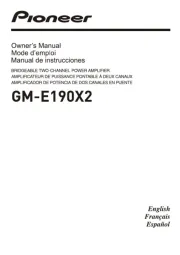
5 April 2025
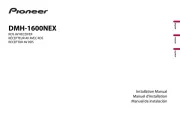
30 Maart 2025

3 Mei 2024

12 Juli 2023

4 Juli 2023

3 Juli 2023

11 Juni 2023

10 Juni 2023

6 Juni 2023

5 Juni 2023
Handleiding Receiver
- Audix
- AVMATRIX
- Arcam
- Kemo
- Rane
- Hegel
- Linn
- Marshall
- Clare Controls
- Chord
- Lyngdorf
- Comprehensive
- Panduit
- Harper
- JTS
Nieuwste handleidingen voor Receiver
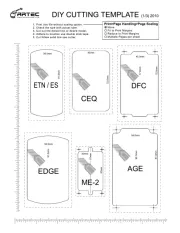
30 Juli 2025
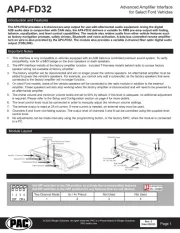
29 Juli 2025
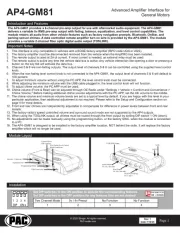
29 Juli 2025
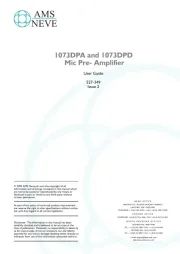
29 Juli 2025
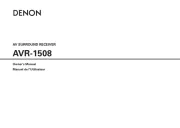
29 Juli 2025
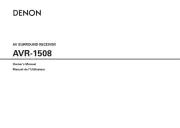
29 Juli 2025
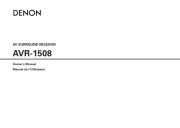
29 Juli 2025
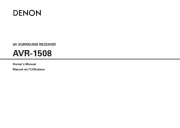
29 Juli 2025

29 Juli 2025
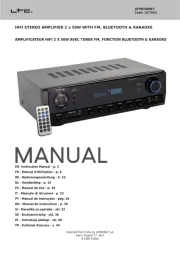
28 Juli 2025